A.P. or AP - Abbreviation for artist's
proof. AP can also stand for "Approved Product," meaning non-toxic , when seen
in the "AP seal" placed on manufactured
art materials by the Art & Creative Materials Institute
(ACMI).
, when seen
in the "AP seal" placed on manufactured
art materials by the Art & Creative Materials Institute
(ACMI).
Products bearing the AP Approved Products Seal are "certified by ACMI to contain no materials in sufficient quantities to be toxic or injurious to humans or to cause chronic or acute health problems. These products are safe to use in the classroom, even with young children." The satement "Confroms to ASTM D-4236" indicates that the product conforms to the labeling standards of the Hazardous Art Materials Act. If the product is non-toxic, then no warning needs to be included on the label. "However, if the product is found to carry acute or chronic health hazards, the information on the label must alert the consumer to those hazards."
Also see ASTM International (American Society for Testing and Materials), CL, hazardous, Material Safety Data Sheet (MSDS), poison, safety, science and art, seal, and toxic.
apadana - The great audience hall in ancient Persian palaces.
(pr. APP-ə-DAN-ə)
aperture - An opening. In photography, the circular hole in the front of the camera lens which controls the amount of light allowed to pass on to the film from the lens. On all but very inexpensive cameras the size of the aperture is variable. The degree of variability is indicated by "f" numbers (f/stop). A great way to gain an understanding of apertures is to make and use a pinhole camera.
apex - The highest point or summit. Also see aculeate, finial, and tower.
aphorism - An adage; a brief statement of a principle, or an opinion held to be true or deeply felt.
Examples of works employing aphorisms:

Eric Gill (English, 1882-1940), Inscription 'Ex Divina Pulchritudine',
1926, Hoptonwood stone relief, 30.6 x
45.7 x 3.8 cm, Tate Gallery, London. This Latin inscription
is an aphorism meaning, "The beauty of God is the cause
of the being of all that is." See capital
letters.
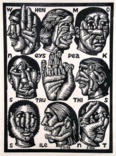
Peter Gourfain (American, 1934-), Hen Eys Tru Ile, 1993, linoleum cut on handmade paper. Peter Gourfain is fascinated by language and has developed his own alphabet (used here in his signature), and many of his works incorporate palindromes — words or phrases that read the same backward as forward. The title of this work is culled from the apparently random vertical sorting of one column of letters, which, when read in normal sequence offer the aphorism,“When money speaks truth is silent.” The four corner heads are inhabited by another sort of text: signing hands that spell out F-E-A-R.

Jenny Holzer (American, 1950-), Raise Boys and Girls the Same Way and Abuse of Power Comes as No Surprise from the series Truisms T-Shirts, 1980-, multiple of screenprint on T-shirt, publisher: the artist, NY, printer: Artisan Silkscreen, NY; edition: unlimited; Museum of Modern Art, NY.
Many artists' writings are simply collections of their aphorisms.
Also see calligraphy and text.
a posteriori - Latin for "from the latter." In logic, an argument that deduces causes from their effects; inductive reasoning; the converse of a priori.
apotropaic - Greek for "turning away," refers to objects designed to ward off evil, as a good luck charm, amulet, or talisman is intended to avert ill fortune. In cultures as varied as those of ancient Greece and contemporary Tibet, apotropaics have usually been employed to work against the "evil eye," and are often themselves images of eyes.
An example:
Greek, Attic, Black-Figure Eye Cup with Ships, Archaic, c. 530 BCE, terra cotta, Carlos Collection of Ancient Greek Art. The eyes serve an apotropaic purpose, warding away evil influences. See anthropomorphism and vessel.
Also see ex voto, fetish, sight, and votive.
appearance - In philosophy, what is visible, or manifest to the senses, but what is ultimately illusory. Appearance is usually contrasted with reality, and so the term often occurs in the schools of philosophy known as idealism and skepticism.
Quote:
Also see appropriation, ASTM International (American Society for Testing and Materials), copy, counterfeit, forgery, irony, likeness, marbling, mirror, representation, sight, simulacrum, simulation, stimulate, and verisimilitude.
apply, application - To apply one material to another is to place it on another surface. Application is such an act of placement, as when a mark is left behind by a brush loaded with paint, by an eyedropper loaded with dye, or a crayon, pencil, or pen. Also, application can refer to a use of learned material in new and concrete situations. Application represents the third level of learning outcomes in the cognitive domain — the level of understanding just beyond comprehension (basic understanding of meaning). This may include the application of such things as rules, methods, concepts, principles, laws, and theories. Objectives of lessons which will increase a student's to apply knowledge can be stated with such behavioral terms as: apply, carve, classify, collect, compute, construct, demonstrate, dramatize, draw, employ, exploit, frame, imitate, make, make use of, manipulate, model, modify, organize, operate, paint, practice, predict, prepare, put in action, put to use, profit by, relate, schedule, sculpt, sequence, show, sketch, solve, try, take up, test out, use, utilize, and wield. The next higher thinking skill is analysis. Application might instead refer to a piece of computer software.
Also see Bloom's Taxonomy.
applied arts - The arts concerned with making objects with functional purposes, but for which aesthetic concerns are significant. The applied arts may include architecture, interior design, the design of manufactured items, ceramics, metalwork, jewelry, textile, glass, furniture, graphics, clocks and watches, toys, leather, arms and armor, musical instruments, etc. Commercial art may be considered a branch of applied art. The applied arts are usually contrasted with the fine arts (drawing, painting, sculpture, fine printmaking, etc.), which are seen as serving no purpose other than providing an aesthetic experience. Most of the applied arts might also be described as design. The distinction between the applied and the fine arts did not emerge strongly until the time of the Industrial Revolution (about 1775-1875), and accompanied a growing secularization of art and the emergence of a need felt by some artists to replace dying spiritual values with purely aesthetic values, setting art apart from the rest of life. Nevertheless, some have emphasized the importance of craft and regard the distinction between the fine and the applied arts as false and undesirable. Even to those who see it as important to make this distinction, many objects make it very difficult because their purposes are so dominated by their aesthetic ones.
Also see high art, decorative arts, low art, and raffia.
appliqué - A design made by stitching pieces of colored fabric onto a larger piece of cloth. Appliqué is used for wall hangings and as decoration on clothing, quilts and pillows.
(pr. APP-lə-KAY)
Example of appliqué:

Sarah Furman Warner Williams (American, New
York, NY), Appliquéd Coverlet, c. 1800, linen,
cotton, and silk, 103 1/4 x 90 1/2 inches (262.3 cm x 229.9 cm),
Metropolitan Museum of Art, NY.
Also see costume, folk art, pattern, and textile.
appraisal - A type of analysis and evaluation, especially in an official or professional capacity. In appraising works of art, for instance, an art appraiser studies their various qualities, and ultimately estimates their monetary worth, typically for insurance or taxation reasons, or in establishing a price.
Resource concerning appraisal:
Also see art careers.
appreciate, appreciation, and appreciable - To perceive the quality, significance, monetary worth, etc. of a person or thing. To be fully aware of or sensitive to. Like appraisal it comes from the Latin verb "appretiare" — "to set a price on." It belongs to a family of "perception" synonyms: acknowledge, apprehend, detect, discern, discover, identify, know, note, notice, observe, pick out, realize, recognize, and sense.
Art appreciation is the introduction of basic principles of visual literacy — especially the means to analyzing form without reference to subject matter, symbolism or historical context — to general audiences for the purpose of enhancing their enjoyment of works of art. Most contemporary art critics and art historians shy away from this term, disparaging art appreciation as demanding too little serious thought. Art educators must be forgiven for providing young students an easily digestible introduction to art. Nevertheless, given the poor reputation of art appreciation, any program of sophistication would better introduce students to art production, along with art in context and as inquiry: aesthetics, art criticism, and art history.
"Appreciable" means capable of being perceived or measured. "Appreciable" applies to what is highly noticeable or definitely measurable. "Perceptible," applies to what can be discerned to a minimal extent. "Sensible" refers to something that is clearly perceived; a sensible difference in someone's expression is easily detected. "Palpable" applies to something that, if it doesn't have actual physical substance, is nevertheless quite noticeable via the senses ("a palpable chill in the air"). "Tangible" is used for something capable of being handled or grasped, either physically and mentally.
(pr. ə-PREE-shee-ayt, ə-PREE-shee-AY-shn, ə-PREE-shə-bəl)
Quote:
Also see art criticism, art history, critique, gestalt, optical, seeing, empiricism, epistemology, iconoduly, ontology, and phenomenology.
apprentice - A person who is learning an art, a craft or occupation from one or more masters of that work. This was the prevailing means of entering many professions in Europe from the Middle Ages to the nineteenth century.
Examples:
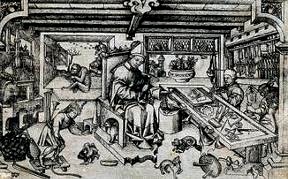
Master of Balaam (Dutch), St. Eligius in His Studio, c. 1450, engraving on paper, 11.5 x 18.5 cm, Rijksmuseum, Netherlands. A man in a bishop's mantle is working in a metalsmiths workshop. "The man is Eligius, patron saint of smiths. He is hammering a goblet into shape on his anvil. Three other people are working in the studio: a master smith and two apprentices. The table is covered with tools. On the right, hammers, tongs and files hang in orderly rows against the wall. On the left is the furnace."
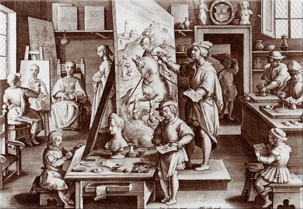
Jan van der Straet (Stradanus) (Dutch, 1523-1604),
Painter's
Studio, woodcut.
As the master paints a large
canvas with
a picture of St. George
and the Dragon at the center, an apprentice paints a portrait from a model at left, two make drawings and one mixes colors in the foreground,
two more grind pigments into
oil on the right, and a last
one carries a canvas toward the doorway. Windows let in natural
light from several angles. There are numerous shelves, drawers
and tables for supplies and works-in-progress. See studio.
Also see apprenticeship and masterpiece.
apprenticeship - A specified amount of time in which a person, called an apprentice, becomes bound by legal agreement to work for another, his master, in return for instruction in an art, a craft, or a business. Once an apprentice completes his term of apprenticeship he would be called a journeyman. He would become a master in his turn only when recognized masters judge an example of his work as worthy to have been made by a master — a masterpiece. The apprenticeship system was common across Europe when guilds were strong in the Middle Ages until the arrival of the Industrial Revolution (about 1775-1875). Leonardo da Vinci (Italian, 1452-1519), for example, was apprenticed to Andrea del Verrocchio (Italian, 1435-1488), in whose work art historians believe they see young Leonardo's work appear and mature. This system has been replaced almost completely by formal schooling and the free-market's gallery system.
a priori - Latin for "from what comes before." In logic, an argument that is known to be true, or false without reference to experience; the converse of a posteriori.
apsara - In India, a nymph of the sky or air. In Chinese Buddhism, a heavenly maiden.
Also see Chinese art and Hindu art.
apse - The semicircular or polygonal recess at the end of a Christian church opposite the main entry, or in a wall of a Roman basilica. It was here that the altar was placed.
Example:
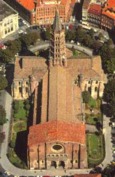

France, Toulouse, St. Sernin, c. 1080-1120,
Romanesque cathedral.
An
aerial
view photograph of St. Sernin from one angle (the tower dates from 1250; its spire of 1478 belongs
to the Gothic
period) and from another angle.

A photo of the exterior of the apse.

A view of the nave of St. Sernin, at the far end of which
the altar is located in the
apse.
Also see aerial view, apse, axonometric projection, capital, chapel, nave, niche, and plan.
aqua fortis - Latin for nitric acid. In etching, the mordant or solution used to etch the plate, diluted for use with one to five parts water.
aquagraph - A monoprint made by painting with a water medium on a metal, glass, or plastic plate and pulling one print from that plate. Additional colors can be printed by aligning the paper to the plate design.
aquamanile - An aquamanile is a vessel for pouring water used in the ritual of washing hands in both religious and secular contexts — by priests before Mass (Christian) and in private households before meals. In form, these ewers are often zoomorphic, and may portray either real or imagined creatures, typically significant in religious iconography. The height of production and use of aquamanilia spans from the fifth to the fifteenth centuries.
Examples:
Master Suleiman (Iranian, Abbasid caliphate), Aquamanile in the Form of an Eagle, 180 AH / CE 796-797, bronze, silver, copper, 38 x 45 cm, Hermitage Museum, St. Petersburg, Russia. This aquamanile originally had a handle on its top.

Ali ibn Muhhamad ibn Abu'l-Qasim an-naqqash
(Iranian), Aquamanile in the Form of a Cow with its Calf,
CE
1206, bronze, silver,
height 35 cm, Hermitage Museum, St. Petersburg, Russia. See Islamic art.
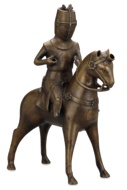
England, late 13th century CE, Bronze Aquamanile, bronze, height 33.0 cm, British Museum, London. See equestrian art.

Southern Netherlands or Eastern France (Lorraine),
Aquamanile: Aristotle Ridden by Phyllis,
c. 1400, bronze, height
13 1/4 inches (33.5 cm), Metropolitan Museum of Art, NY. The
humanistic allegory portrayed in this aquamanile
is Phyllis's humiliation of Aristotle.

Benin, Africa, Nigeria, Leopard Aquamanile, 18th century, bronze, 17 x 26 inches, Minneapolis
Institute of Arts. The King of Benin, called the "Oba," honored his paternal ancestors in a ceremony in which vessels
such as this were used for the ritual washing of hands. See African art.
aquamarine - A blue to green, transparent kind of beryl, or simply a pale blue to pale greenish blue color.
aquamedia - See watercolor, acrylic, casein, gouache, and egg tempera.
aquarelle - The technique of drawing or painting with transparent watercolor, or a piece of work made this way. French for "watercolor."
aquarelle brush - A particular style of watercolor brush, used flat for large areas and on the edge for fine light.
aquatint mezzotint - In etching, a plate is first bitten in a solid aquatint, then a design is worked on top of the aquatint with a scraper and burnisher, producing a result similar to an ordinary mezzotint.
aqueduct - A channel built to carry water to towns and cities. In some places these channels were supported by a series of arches. The Romans built many aqueducts, including the Pont du Gard near Nimes, France, and those found in Spain at Tarragona and Segovia.
Examples:

Roman, Pont du Gard Aqueduct, near Nimes, France,
c. 20-10 BCE.
See Roman art.
Allegeheny Aqueduct in Gibraltar carried the Schuylkill Canal over the Allegeheny Creek, Berks County, PA. Photograph by Doug Reinert.

American, View of Rochester with a section of the Aqueduct,
1830, wood engraving, 11
x 7 inches. This is what was then the newly completed first aqueduct
over the Erie Canal, printed
to illustrate a story in the
Monthly Repository and Library of Entertaining Knowledge,
volume 1, number 5, published October, 1830. A canal boat can
be seen crossing the aqueduct.
Also see architecture.
aqueous - Watery. Often used to designate pigmented media in which water is an ingredient in the vehicle, as in gouache, tempera, and watercolors. Such media are water-soluble.
Also see miscible, solvent, viscosity, and wetting agent.
aqueous humor - Physically essential to sight, a clear, watery fluid found in the anterior chamber of the eye.
Related resource:
Also see lens, ophthalmology, optical, perception, pupil, retina, and vitreous humor.
A.R.A. - Associate of the Royal Academy (or Royal Academy of Arts) (RA). When you see these initials at the end of an artist's signature, you know the signer is a member of Britain's Royal Academy.
Also see academy.
arabesque - A complicated, intertwined, flowing design of stylized floral and plant motifs loosely based on Arabian decoration.
(pr. A-rə-besk)
Examples:
Safavid Persia, Corcoran Throne Rug, fragment of a carpet, Shah Abbassi design, 119 x 106 cm, Corcoran Gallery Washington, DC. See textile.
![]()
John La Farge (American, 1835-1910), Window (Persian Arabesque), 1882, stained glass,
50 1/4 x 34 x 2 1/8 inches.
Also see grotesque, Islamic art, mehndi, Mesopotamian art, paisley, palmette, and pattern.
Arabian art - See Islamic art and Mesopotamian art.
Aramaean art - See Mesopotamian art.
arc - A portion or section of a curved line; a single curve or arch. In strict mathematical terms, a segment of a circle. An example of this shape can be seen in the green background to this page.
In electricity, a glowing discharge of
current, formed when a current jumps a gap in a circuit or between
electrodes.
arcade - A series of arches on column, pier, or pillars. Also, a roofed passageway or gallery, especially with shops on one or both sides. Only in the last century has arcade also come to refer to commercial establishments featuring rows of coin-operated games.
Examples:

Roman,
Rome, Colosseum
(Flavian Amphitheater), 70-82 CE.
A vast ellipse in plan,
length 620 feet x width
513 feet (188 x 156 m), with
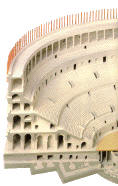 eighty external arcaded openings on each storey, those on the
ground floor forming entrances from which the various tiers
of seats were reached.
eighty external arcaded openings on each storey, those on the
ground floor forming entrances from which the various tiers
of seats were reached. See a cutaway view. The upper storey was added
222-224, around the top of which were sockets for 240 wooden
masts which carried a massive canopy (velarium). The façade's
entire height is 157 feet 6
inches (48.5 m). Each of the four storeys are pierced by arches, and have attached
three-quarter columns and
entablatures, Doric
in the first story, Ionic
in the second, Corinthian
in the third, and above these are pilasters
of Corinthian design, with small square window openings in alternate
bays. Another view of the Colosseum.
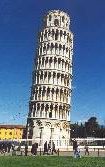
Leaning Tower of Pisa, Italy, 1174,
this campanile has eight stories
of arcades, with a diameter
of 52 feet, its original height
was 151 feet 3 inches. The belfry was added in 1350. The principle
reason for its fame is that it is not perpendicular
-- it's about 12º away from vertical.
See tower. See angle and diagonal.

Giorgio de Chirico (Italian, 1888-1978),
Ariadne, 1913, oil
and graphite on canvas,
53 3/8 x 71 inches (135.6 x 180 cm), Metropolitan Museum of Art,
NY. See Metaphysical Painting.
archaeology - The scientific study of material evidence, such as burials, architecture, tools, and pottery remaining from past cultures — primarily but not exclusively those of Stone Age and ancient period. Its principal activities include preliminary field surveys, excavation, and the classification, dating, and interpretation of finds. Towards the end of the nineteenth century archaeology became an academic study, making increasing use of scientific techniques and systematic methods. Archaeologists are the people who are trained in making field expeditions to uncover materials in ruins, deserts, jungles, and so on. They locate, excavate, catalog, analyze, and conserve their finds, many of which are displayed in museums.
Also see Aegean art, American Indian art, Chinese art, civilization, Cycladic art, Egyptian art, Etruscan art, excavate, Greek art, interdisciplinary, Japanese art, Meroitic art, Pre-Columbian art, Roman art, science and art, and tradition.
archaic - This adjective is applied to the early stage in the development of an art style. It is at this stage that the characteristics of the fully developed style are found, although in simpler forms. The term is often used to describe the art of ancient Greek artists whose early sculpture were a step in the direction of more natural figures. The term may also describe work which conveys characteristics of earlier art; old-fashioned.
(pr. ər-KAY-ək)
archetype - An original model like which others are formed; an avatar. Can also be an example that is an ideal form of its type; the perfect or typical specimen. Archetypes are recurring motifs in mythology and the arts. According to the theories of psychiatrist Carl Jung (Swiss, 1875-1961), an archetype indicates a mythic character which is present in the unconscious of humanity — crossing all spatial, cultural and historical boundaries.
Also see exemplar, prototype, and realia.
architectonic - Architectural qualities, as observed in subjects which are not typically architectural ones. For instance, "architectonic" is used as the name of the second style of classical Roman fresco painting, in which painters covered walls with such architectural elements as columns and porticos, punctuated with illusory windows revealing scenic landscapes. One reason the architectonic style was so effective was it use of linear perspective — long before its reinvention in the Renaissance. This style of fresco was in fashion most of the 1st century BCE.
Example:

Rome, Cubiculum (bedroom) from the Villa of P. Fannius
Synistor, c. 40-30 BCE,
Republican, architectonic style, fresco;
room: 8 feet 8 1/2 inches x 10 feet 11 1/2 inches x 19 feet 7
1/8 inches (265.4 x 334 x 583.9 cm), Metropolitan Museum of Art,
NY. See cubiculum.
Related link:
The architectonic style of Roman wall painting was preceded in popularity by a style called "incrustation," and followed by another called "ornamental." The last of the four styles displayed a combination of the traits of the first three.
architrave - In classical architecture, the lintel or lowest part of an entablature, sometimes called the epistyle.
(pr. ar-KAY-ək)
Examples:
Architraves as they figure into a diagram of the Doric order and a diagram of the Ionic order.
Also see abacus, capital, column, Corinthian, cornice, Doric, echinus, entablature, frieze, Greek art, Ionic, metope, orders, Roman art, shaft, and stylobate.
archival image - An image meant to have lasting utility. An archival digital image is generally an image kept off-line in a safe place, and it's often of higher quality than the digital image delivered to the user.
(pr. ar-KI:-vəl)
An archive joke:
Question: When Noah put all the creatures onto the Ark, where did he put the bees?
Answer: In the archives! (Arc-hives!)
Related links:
Also see acid-free, art conservation, and fugitive colors.
arcuated - Of arch-column construction.
arc welding - Joining two pieces of metal
by fusion through heating with an electrical arc. In addition,
pressure may or may not be exerted, and a filler rod may or may
not be used. This welding technique is different than welding
using an oxyacetylene torch.
argilaceous - Of the nature of clay; clayey.
(pr. AR-jə-LAY-shəs)
argon - A non-explosive, colorless, odorless, tasteless,
inert gaseous element used in electric light bulbs, fluorescent
tubes, and neon tubes,
and as an inert gas shield in arc welding.
Atomic symbol Ar, atomic number 18, atomic weight 39.94, melting
point -189.2°C, boiling point -185.7°C. Tank sizes available
are 131, 330, and 4754 liquid cubic feet.
Also see acetylene, carbon dioxide, helium, hydrogen, nitrogen, and oxygen.
argument - While commonly any discussion in which there is disagreement, art criticism is a matter of giving reasons which demonstrate the truth of claims about a work. This requires the use of logic. An extended argument consists of a main conclusion supported by premises, some being conclusions of related arguments.
Also see a priori, a posteriori, assessment, charette, critique, and syllogism.
armature - A skeleton-like framework to give rigid internal support to a modeled sculpture. Such sculptures are typically of either clay or wax. Armature wire used to build an armature is available in various gauges. A basic linear form in wire can be made with poultry screen or padded with wood or paper if appropriate. The medium is modeled directly onto the armature.
An example of a work in which an armature was used:
Annibale Fontana (Italian, Milan, 1540(?)-87), Adoring Angel, 1583-84, wax with metal armature on wooden base, height (with base) 21 3/4 inches (55.2 cm), Los Angeles County Museum of Art.
Also see papier-mâché and statue.
arrangement - An order or composition. Or, a setup or composition of components in a still life painting or drawing. Arrangement is at the heart of the principles of design, and its consideration determines a work's coherence (unity and variety), focal point, rhythm, etc. As such, there are many parallels to its importance in music. Arrangement is important to all other disciplines as well. In architecture, it is the subject of the traditional Chinese theory and practice of feng shui.
An example:
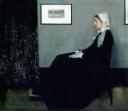
James Abbott McNeill Whistler (American,
1834-1903, active England), Arrangement in Grey and Black No. 1: Portrait
of the Artist's Mother, 1871, oil
on canvas, 4 feet 8 3/4 x
5 feet 3 3/4 inches, Musée d'Orsay, Paris, France. With
planes and shapes
flattened, and color
muted, Whistler's portrait demonstrates
his devotion to aestheticism
and art for art's sake.
Accordingly, Whistler prefered to describe this paintings as
an arrangement — much as music is an arrangement of pure forms — making him a precursor
to abstract art. See rectangle.
Also see abecedarian, align and alignment, attitude, bias, choose, chronology, concatenation, direction, heraldry, ikebana, juxtaposition, periodicity, regular, sequence, straight, taxis, taxonomy, and weight.
Arretine ware - See terra sigillata
arsenic - A highly poisonous metal,
usually found in a brittle, crystalline
gray form. It was frequently used in
early copper alloy.
Elemental symbol As; atomic number 33; atomic weight 74.922; melting
point 817°C (at 28 atm pressure); specific gravity 5.73; valence
3, 5.
https://inform.quest/_art